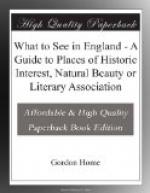If one enters through the park gates, near Savernake Station, the house (formerly known as Tottenham House) lies on the right, and in the opposite direction one may notice, at the end of a perspective formed by great masses of elms and beeches, the column erected in 1781 by the first Earl of Ailesbury (the marquisate was not created until 1821), commemorating the recovery of George III. and other circumstances.
If one crosses the avenue and bears off to the right across the turf the church of St. Catherine will soon appear in sight. It is a very richly ornamented structure, and was built by a former Marchioness of Ailesbury, in memory of her mother the Countess of Pembroke. Returning to the avenue, one may continue down it for about 3 miles to the “eight walks,” where an opening in the ranks of the stately trees reveals a number of grassy glades running off to the chief points of the compass. The walk going off to the south-west leads to the King’s Oak, a gigantic tree whose hollow trunk is 24 feet in circumference. This oak is surrounded by a number of grand old trees, their bold outlines enriched with velvety moss. On an autumn afternoon, when the forest is a blaze of crimson and yellow, this spot is seen at its loveliest—the long shadows and the golden sunlight giving the scene a painted, almost too brilliant effect.
[Illustration: E.H. Roberts.
THE AVENUE IN SAVERNAKE FOREST.]
ELY CATHEDRAL
=How to get there.=—From Liverpool Street
or St. Pancras. Great
Eastern Railway.
=Nearest Station.=—Ely. =Distance from
London.=—70-1/2 miles. =Average Time.=—Varies
from 1-3/4 to 3-1/4 hours. Quickest train 1 hour
38 minutes.
1st
2nd 3rd
=Fares.=—Single 11s. 3d. ... 5s. 11-1/2d.
Return
20s. 0d. ... 11s. 11d.
=Accommodation Obtainable.=—“Bell Hotel” and others.
Ely is situated on an eminence in the midst of the flat district forming the centre of the county of Cambridge, and was originally a settlement termed by the Saxons Eleg or Elge, i.e. “an eel,” from the number of eels found in the fenny district around. St. Etheldreda, daughter of a king of the East Angles, founded an abbey here, where she died in 679, being afterwards canonised as a saint. The monastery was destroyed by the Danes in 870, and did not regain importance till one hundred years later.
In Hereward the Wake Kingsley tells us how gallantly the Isle of Ely was defended against the attacks of William the Conqueror, but the chieftain was at last forced to surrender, and the monastery was seized. Ely was created a bishopric by Henry I. in 1107.
The cathedral is one of the most beautiful and remarkable in England. The oldest portion was erected in the reign of William Rufus and Henry I., and additions were continually made to the fabric until 1534, so that it contains an almost unbroken series of the architectural styles prevailing from the Conquest, yet so wonderfully has the design been managed that no disagreeable effect is produced.




